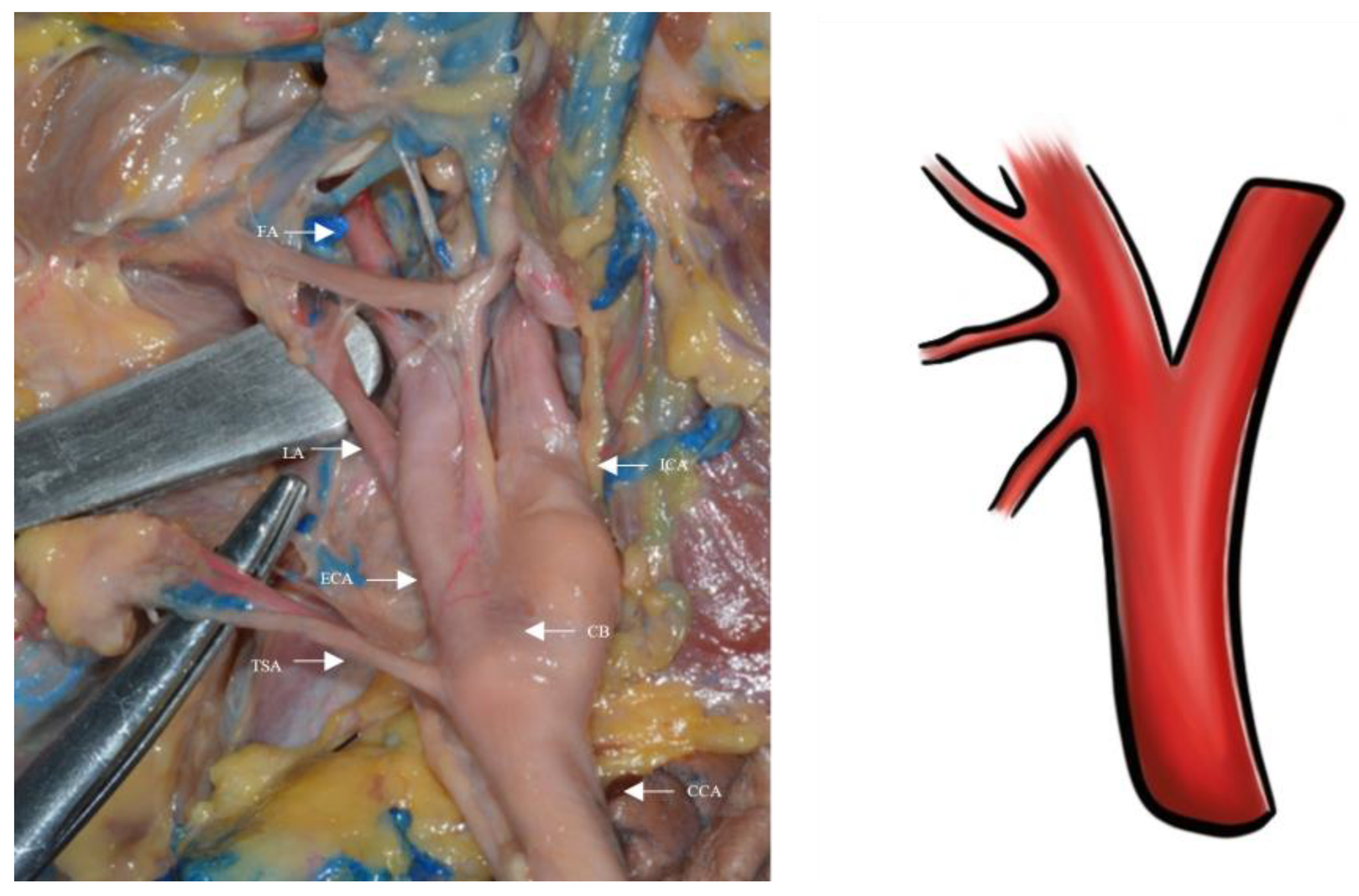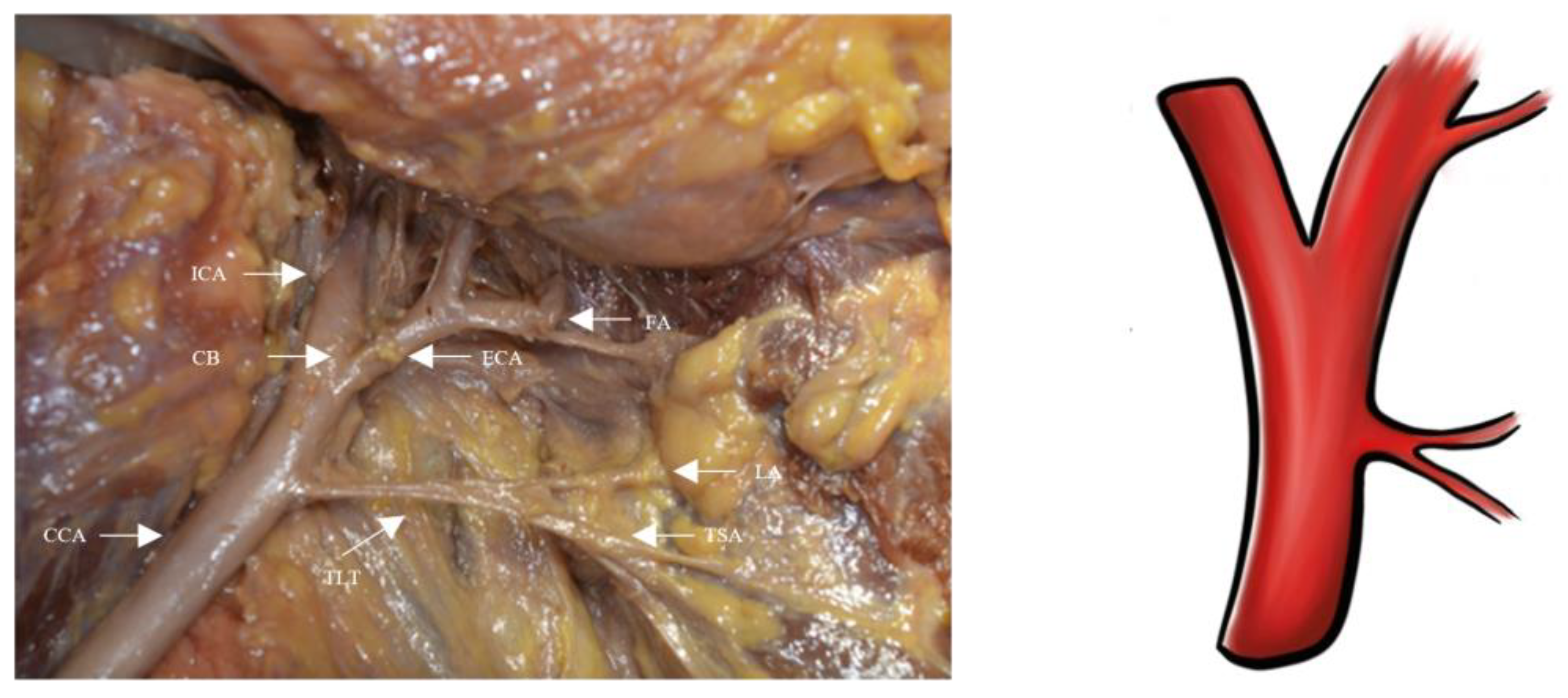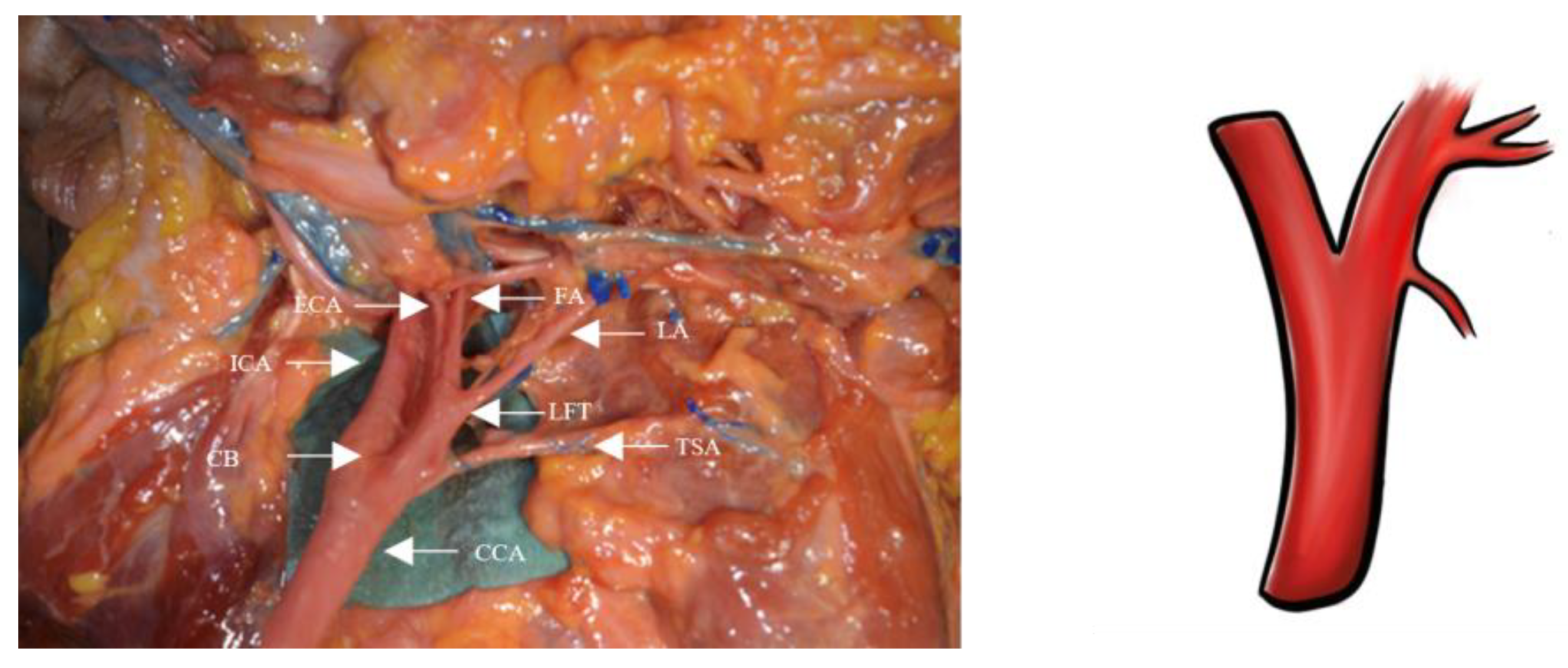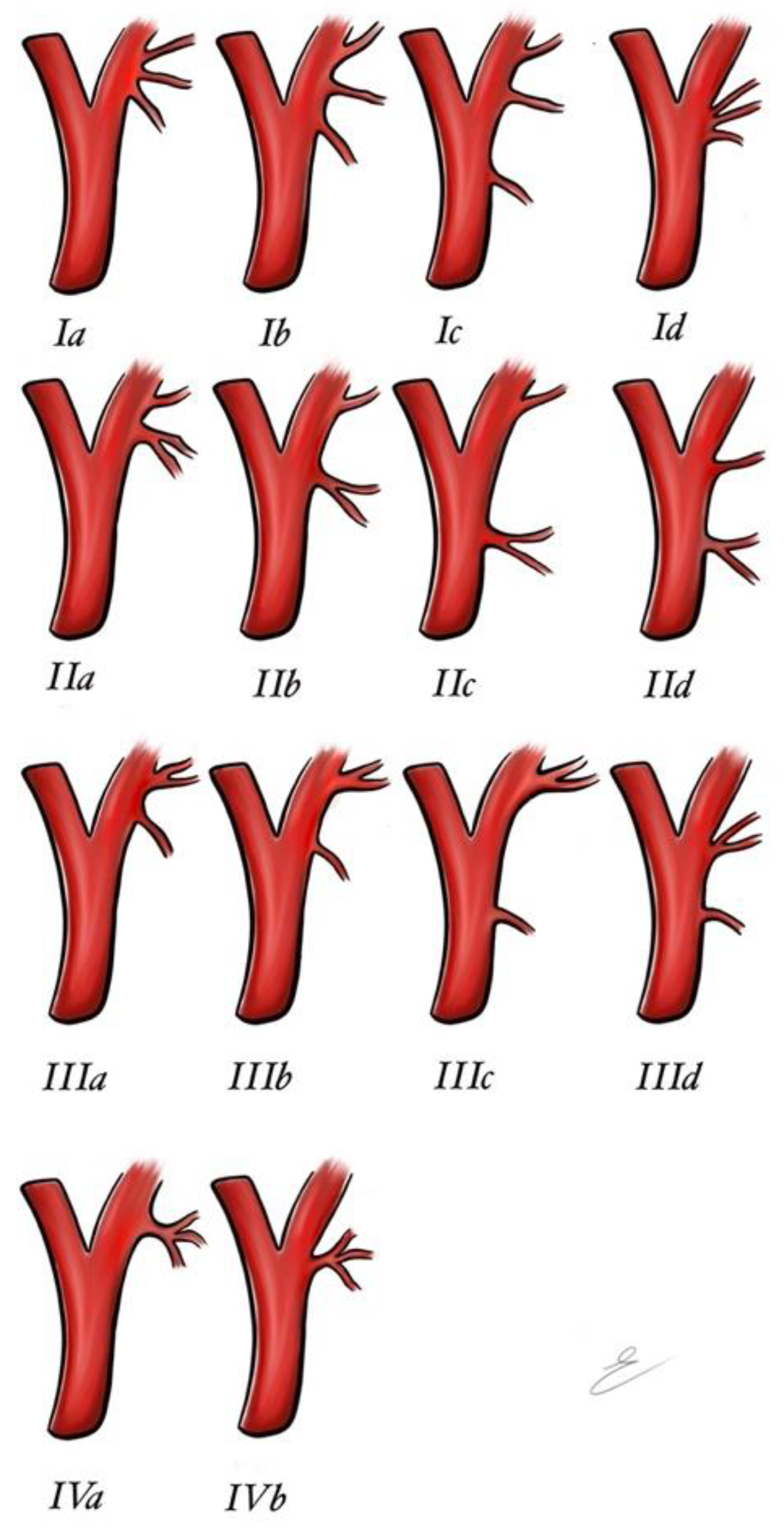Configuration Origin Variants of Superior Thyroid, Lingual and Facial Arteries: A Proposal Updating of Current Classification
Abstract
1. Introduction
2. Materials and Methods
3. Results

| Variation Type | Right n (%) (n = 50) | Left n (%) (n = 50) | Female n (%) (n = 24) | Male n (%) (n = 76) | Total n (%) (n = 100) | |
|---|---|---|---|---|---|---|
| Ia | 20 (40) | 18 (36) | Type I | 14 (58.33) | 68 (89.47) | 82 (82) |
| Ib | 14 (28) | 19 (38) | ||||
| Ic | 7 (14) | 4 (8) | ||||
| IIa | - | 1 (2) | Type II | 1 (4.16) | - | 1 (1) |
| IIb | - | - | ||||
| IIc | - | - | ||||
| IIIa | 6 (12) | 6 (12) | Type III | 9 (37.5) | 7 (9.21) | 16 (16) |
| IIIb | - | 1 (2) | ||||
| IIIc | 3 (6) | - | ||||
| IV | - | - | - | - | - | |
| Unclassified | - | 1 (2) | Unclassified | - | 1 (1.32) | 1 (1) |
4. Discussion
5. Conclusions
Author Contributions
Funding
Institutional Review Board Statement
Informed Consent Statement
Data Availability Statement
Acknowledgments
Conflicts of Interest
References
- Lo, A.; Oehley, M.; Bartlett, A.; Adams, D.; Blyth, P.; Al-Ali, S. Anatomical variations of the common carotid artery bifurcation. ANZ J. Surg. 2006, 76, 970–972. [Google Scholar] [CrossRef]
- Devadas, D.; Pillay, M.; Sukumaran, T.T. A cadaveric study on variations in branching pattern of external carotid artery. Anat. Cell Biol. 2018, 51, 225–231. [Google Scholar] [CrossRef] [PubMed]
- Hayashi, N.; Hori, E.; Ohtani, Y.; Ohtani, O.; Kuwayama, N.; Endo, S. Surgical anatomy of the cervical carotid artery for carotid endarterectomy. Neurol. Med. Chir. 2005, 45, 25–29. [Google Scholar] [CrossRef] [PubMed]
- Herrera-Núñez, M.; Menchaca-Gutiérrez, J.L.; Pinales-Razo, R.; Elizondo-Riojas, G.; Quiroga-Garza, A.; Fernandez-Rodarte, B.A.; Elizondo-Omaña, R.E.; Guzmán-López, S. Origin variations of the superior thyroid, lingual, and facial arteries: A computed tomography angiography study. Surg. Radiol. Anat. 2020, 42, 1085–1093. [Google Scholar] [CrossRef] [PubMed]
- Heltzel, S.; Jelinek, L.; Jaynes, D. Variation in the caudal branches of the external carotid artery: Comparison of sex and side. Med. Res. Arch. 2015, 1, 1–10. [Google Scholar] [CrossRef]
- Zümre, O.; Salbacak, A.; Ciçekcibaşi, A.E.; Tuncer, I.; Seker, M. Investigation of the bifurcation level of the common carotid artery and variations of the branches of the external carotid artery in human fetuses. Ann. Anat. Anat. Anz. 2005, 187, 361–369. [Google Scholar] [CrossRef]
- Natsis, K.; Raikos, A.; Foundos, I.; Noussios, G.; Lazaridis, N.; Njau, S.N. Superior thyroid artery origin in Caucasian Greeks: A new classification proposal and review of the literature. Clin. Anat. 2011, 24, 699–705. [Google Scholar] [CrossRef]
- Ozgur, Z.; Govsa, F.; Ozgur, T. Assessment of origin characteristics of the front branches of the external carotid artery. J. Craniofacial Surg. 2008, 19, 1159–1166. [Google Scholar] [CrossRef]
- Vazquez, T.; Cobiella, R.; Maranillo, E.; Valderrama, F.J.; McHanwell, S.; Parkin, I.; Sañudo, J.R. Anatomical variations of the superior thyroid and superior laryngeal arteries. Head Neck 2009, 31, 1078–1085. [Google Scholar] [CrossRef]
- Fazan, V.P.; da Silva, J.H.; Borges, C.T.; Ribeiro, R.A.; Caetano, A.G.; Filho, O.A. An anatomical study on the lingual-facial trunk. Surg. Radiol. Anat. 2009, 31, 267–270. [Google Scholar] [CrossRef]
- Thwin, S.S.; Soe, M.M.; Myint, M.; Than, M.; Lwin, S. Variations of the origin and branches of the external carotid artery in a human cadaver. Singap. Med. J. 2010, 51, e40–e42. [Google Scholar]
- Troupis, T.; Michalinos, A.; Dimovelis, I.; Demesticha, T.; Vlasis, K.; Skandalakis, P. Bilateral abnormal origin of the anterior branches of the external carotid artery. Ann. Vasc. Surg. 2014, 28, 494.e5–494.e7. [Google Scholar] [CrossRef]
- Murlimanju, B.V.; Prabhu, L.V.; Pai, M.M.; Jayaprakash, D.; Saralaya, V.V. Variant origins of arteries in the carotid triangle—A case report. Chang Gung Med. J. 2012, 35, 281–284. [Google Scholar] [CrossRef] [PubMed]
- Espalieu, P.; Cottier, M.; Relave, M.; Youvarlakis, P.; Cuilleret, J. Radio-anatomic study of the carotid axis with regard to the implantation of microsurgical vascular anastomoses. Surg. Radiol. Anat. 1986, 8, 257–263. [Google Scholar] [CrossRef]
- Poisel, S.; Golth, D. Zur Variabilität der grossen Arterien im Trigonum caroticum [Variability of large arteries in the carotid trigone]. Wien. Med. Wochenschr. 1974, 124, 229–232. [Google Scholar] [PubMed]
- Czerwiński, F. Variability of the course of external carotid artery and its rami in man in the light of anatomical and radiological studies. Folia Morphol. 1981, 40, 449–453. [Google Scholar]
- Lucev, N.; Bobinac, D.; Maric, I.; Drescik, I. Variations of the great arteries in the carotid triangle. Otolaryngol. Head Neck Surg. 2000, 122, 590–591. [Google Scholar] [PubMed]
- Demirtaş, İ.; Ayyıldız, B.; Demirbaş, A.T.; Ayyıldız, S.; Sönmez Topcu, F.; Kuş, K.C.; Kurt, M.A. Geometric morphometric study of anterior branches of external carotid artery and carotid bifurcation by 3D-CT angiography. Surg. Radiol. Anat. 2022, 44, 1029–1036. [Google Scholar] [CrossRef]
- Shintani, S.; Terakado, N.; Alcalde, R.E.; Tomizawa, K.; Nakayama, S.; Ueyama, Y.; Matsumura, T. An anatomical study of the arteries for intraarterial chemotherapy of head and neck cancer. Int. J. Clin. Oncol. 1999, 4, 327–330. [Google Scholar] [CrossRef]
- Zaccheo, F.; Mariotti, F.; Guttadauro, A.; Passaretti, A.; Campogrande, M.E.; Petroni, G.; Cicconetti, A. A Rare Configuration origin of the Superior Thyroid, Lingual and Facial Arteries in a Pentafurcated Common Carotid Artery. Anatomia 2022, 1, 204–209. [Google Scholar] [CrossRef]
- Acar, M.; Salbacak, A.; Sakarya, M.E.; Zararsiz, I.; Ulusoy, M. The Morphometrical Analysis of the External Carotid Artery and its Branches with Multidetector Computerized Tomography Angiography Technique. Int. J. Morphol. 2013, 31, 1407–1414. [Google Scholar] [CrossRef]
- Cappabianca, S.; Scuotto, A.; Iaselli, F.; Pignatelli di Spinazzola, N.; Urraro, F.; Sarti, G.; Rotondo, A. Computed tomography and magnetic resonance angiography in the evaluation of aberrant origin of the external carotid artery branches. Surg. Radiol. Anat. 2012, 34, 393–399. [Google Scholar] [CrossRef] [PubMed]
- Delić, J.; Savković, A.; Bajtarević, A.; Isaković, E. Variations of ramification of external carotid artery–common trunks of collateral branches. Period. Biol. 2010, 112, 117–119. [Google Scholar]
- Dessie, M.A. Variations of the origin of superior thyroid artery and its relationship with the external branch of superior laryngeal nerve. PLoS ONE 2018, 13, e0197075. [Google Scholar] [CrossRef] [PubMed]
- Jitpun, E.; Wattanasen, Y.; Tirakotai, W. Do Asians have Higher Carotid Bifurcation? A Computed Tomographic Angiogram Study of the Common Carotid Artery Bifurcation and External Carotid Artery Branching Patterns. Asian J. Neurosurg. 2019, 14, 1082–1088. [Google Scholar] [CrossRef]
- Ito, H.; Mataga, I.; Kageyama, I.; Kobayashi, K. Clinical anatomy in the neck region--the position of external and internal carotid arteries may be reversed. Okajimas Folia Anat. Jpn. 2006, 82, 157–167. [Google Scholar] [CrossRef]
- Klosek, S.K.; Rungruang, T. Topography of carotid bifurcation: Considerations for neck examination. Surg. Radiol. Anat. 2008, 30, 383–387. [Google Scholar] [CrossRef]
- Kaneko, K.; Akita, M.; Murata, E.; Imai, M.; Sowa, K. Unilateral anomalous left common carotid artery; a case report. Ann. Anat. Anat. Anz. 1996, 178, 477–480. [Google Scholar] [CrossRef]
- Aziz, M.A.; McKenzie, J.C.; Wilson, J.S.; Cowie, R.J.; Ayeni, S.A.; Dunn, B.K. The human cadaver in the age of biomedical informatics. Anat. Rec. 2002, 269, 20–32. [Google Scholar] [CrossRef]
- Ghosh, S.K. Cadaveric dissection as an educational tool for anatomical sciences in the 21st century. Anat. Sci. Educ. 2017, 10, 286–299. [Google Scholar] [CrossRef]





Disclaimer/Publisher’s Note: The statements, opinions and data contained in all publications are solely those of the individual author(s) and contributor(s) and not of MDPI and/or the editor(s). MDPI and/or the editor(s) disclaim responsibility for any injury to people or property resulting from any ideas, methods, instructions or products referred to in the content. |
© 2023 by the authors. Licensee MDPI, Basel, Switzerland. This article is an open access article distributed under the terms and conditions of the Creative Commons Attribution (CC BY) license (https://creativecommons.org/licenses/by/4.0/).
Share and Cite
Zaccheo, F.; Petroni, G.; Guttadauro, A.; Passaretti, A.; Campogrande, M.E.; Tenore, G.; Mohsen, A.; Cicconetti, A. Configuration Origin Variants of Superior Thyroid, Lingual and Facial Arteries: A Proposal Updating of Current Classification. Appl. Sci. 2023, 13, 4737. https://doi.org/10.3390/app13084737
Zaccheo F, Petroni G, Guttadauro A, Passaretti A, Campogrande ME, Tenore G, Mohsen A, Cicconetti A. Configuration Origin Variants of Superior Thyroid, Lingual and Facial Arteries: A Proposal Updating of Current Classification. Applied Sciences. 2023; 13(8):4737. https://doi.org/10.3390/app13084737
Chicago/Turabian StyleZaccheo, Fabrizio, Giulia Petroni, Alessandro Guttadauro, Alfredo Passaretti, Maria Elisabetta Campogrande, Gianluca Tenore, Ahmed Mohsen, and Andrea Cicconetti. 2023. "Configuration Origin Variants of Superior Thyroid, Lingual and Facial Arteries: A Proposal Updating of Current Classification" Applied Sciences 13, no. 8: 4737. https://doi.org/10.3390/app13084737
APA StyleZaccheo, F., Petroni, G., Guttadauro, A., Passaretti, A., Campogrande, M. E., Tenore, G., Mohsen, A., & Cicconetti, A. (2023). Configuration Origin Variants of Superior Thyroid, Lingual and Facial Arteries: A Proposal Updating of Current Classification. Applied Sciences, 13(8), 4737. https://doi.org/10.3390/app13084737








